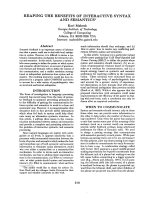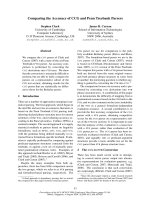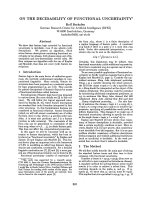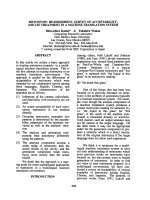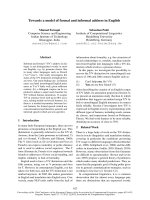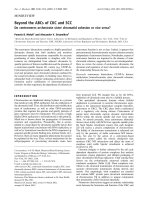Báo cáo sinh học: "Untangling the web of functional and physical interactions in yeast" pdf
Bạn đang xem bản rút gọn của tài liệu. Xem và tải ngay bản đầy đủ của tài liệu tại đây (82.05 KB, 4 trang )
Minireview
Untangling the web of functional and physical interactions in
yeast
Markus J Herrgård and Bernhard Ø Palsson
Address: Department of Bioengineering, University of California, San Diego, 9500 Gilman Drive, La Jolla, CA 92093-0412, USA.
Correspondence: Bernhard Ø Palsson. E-mail:
Reconstructing the structures of the regulatory and signaling
networks operating within and between cells is a key com-
ponent of the ‘systems biology’ approach to understanding
biological processes [1]. The multitude of high-throughput
datasets now available for an increasing number of model
organisms has enabled the development of systematic
approaches for this reconstruction task for specific types of
networks. A number of approaches have been developed for
identifying co-regulated gene modules from gene expression
and protein-DNA binding data [2]. Similarly, protein-protein
interaction data have been used to reconstruct signaling net-
works and protein complexes [3]. These reconstructions form
a blueprint of the networks operating within the cell and
can be used as a starting point for further studies on
network function.
One of the key uses of network reconstructions is decipher-
ing the general organizational principles of biological net-
works; these principles that are commonly studied include
topological and functional modularity [4,5], network
redundancy and robustness [6,7], and pathway cross-talk
[8,9]. For certain types of network, including those involved
in metabolism or well-characterized signaling pathways, such
organizational principles can be discovered through a set of
well-established computational methods in an unbiased
fashion [5,10]. There is, however, a need to develop
approaches for discovering fundamental organizational
principles of integrated networks that combine, for
example, signaling and transcriptional pathways.
High-throughput data about a variety of interactions
between genes (and gene products) can be used both to
reconstruct networks and to elucidate the organizational
principles of these networks. Information about features
such as protein-protein [11] and protein-DNA [12] interac-
tions can be directly interpreted as physical associations
between macromolecules. In principle, such physical inter-
action data types can be used directly to reconstruct signal-
ing and regulatory networks, but the noisiness of
high-throughput datasets makes the reconstruction task
challenging. Other types of interaction information, such as
the list of genetic interactions obtained from synthetic
lethality screens [13] - showing that combination of muta-
tions in two genes causes lethality while either mutation
Abstract
An analysis of an integrated network of over 150,000 functional and physical interactions in
yeast suggests that the network can be hierarchically decomposed into themes and thematic
maps. This decomposition can be used to explore the organizational principles of integrated
biological networks within cells.
BioMed Central
Journal
of Biology
Journal of Biology 2005, 4:5
Published: 8 June 2005
Journal of Biology 2005, 4:5
The electronic version of this article is the complete one and can be
found online at />© 2005 BioMed Central Ltd
alone does not - do not necessarily indicate direct physical
interactions between the gene products. Links between two
genes can also be derived from computational analysis of
datasets that include information about both genes - for
example, on the basis of high gene expression or sequence
similarity. These types of links are also likely to be indirect
in that, in many cases, a direct physical interaction does not
underlie each functional link [14].
The study by Zhang et al. [15] in Journal of Biology presents a
novel approach for integrating multiple types of biological
interactions so as to reconstruct simultaneously the modular
structures of cellular networks and to identify their organiza-
tional principles. The authors use five different yeast datasets
at the same time in order to allow integrated analysis of mul-
tiple data types and to study the interplay of different biolog-
ical network types. The interaction data types include both
direct physical interactions - protein complexes and protein-
DNA interactions - and indirect functional interactions -
genetic interactions and interactions based on gene-expres-
sion correlation and sequence homology. The overall
approach used in this work (see Figure 1) first decomposes
the combined interaction network into significantly enriched
multi-color ‘network motifs’, in which each color corre-
sponds to one type of interaction data, and then assembles
these motifs into ‘network themes’ consisting of overlapping
motifs. The network themes are further assembled into ‘the-
matic maps’ that represent a bird’s-eye view of functional
relationships between different subsystems of the overall
biochemical network.
The network decomposition approach used by Zhang et al.
[15] to untangle the complex network of 154,759 functional
or physical links between a total of 5,831 yeast genes is based
on the concept of network motifs. This concept, first intro-
duced in the context of transcriptional regulatory networks
[16,17], refers to small subnetworks that occur in the overall
network more commonly than is expected by chance. Zhang
et al. [15] extend the concept of a network motif to networks
with multiple types of interaction by considering structurally
similar motifs with different color interactions. The authors
identify enriched three-gene motifs out of the total set of 50
possible three-gene patterns with different types of interac-
tion connecting the genes. Because of the large number of
potential multi-color four-gene motifs, a similar search was
performed for only a small subset of these.
Although network motifs can be considered to be the build-
ing blocks of a graphical representation of biological net-
works, they may not necessarily correspond to functional
building blocks of the actual networks inside a cell. This
observation, originally made in the context of regulatory
networks [18], led Zhang et al. [15] to introduce a new
concept, the network theme, to describe a collection of
overlapping motifs of the same type. For example, multiple
motifs containing a transcription factor that regulates two
physically interacting proteins can be combined into a
single theme corresponding to a protein complex whose
component proteins are controlled by the same transcrip-
tion factor (Figure 1a,b). The same motif-aggregation
process can be applied to other types of multi-color motifs
to identify a range of different types of theme. Many of the
resulting themes correspond directly to modules that can be
identified on the basis of physical interaction data alone,
such as co-regulated gene groups or protein complexes. The
inclusion of functional interaction data, however, allows
the identification of network themes that bridge multiple
types of physical or functional interaction.
The most interesting themes identified by Zhang and
coworkers [15] are ones involving genetic interactions.
These include the ‘alternative subunits’ theme, in which two
genes are connected to each other by synthetic lethal inter-
actions and to other members of the complex by protein-
protein interactions. The second genetic-interaction-based
theme consists of two protein complexes internally con-
nected by protein-protein interactions that are bridged by a
large number of genetic interactions (Figure 1d,e). This
theme indicates a structure in which either of the complexes
is needed to perform an essential function, but the com-
plexes can compensate for one another. Because the same
complex can compensate for the function of more than one
other complex, all the ‘compensatory complex’ themes can
be further assembled into a thematic map (Figure 1f). In
this map, nodes correspond to individual protein com-
plexes and edges to bundles of synthetic lethal interactions
between complexes. The ‘compensatory complex’ map
(Figure 1f) provides a global view of the built-in redundan-
cies in the yeast biochemical network and allows the estab-
lishment of novel links between diverse functional
processes.
Both of the network themes discussed above have genetic
interactions as their core components. The interpretation of
these interactions has attracted increasing attention with the
development of experimental methods for the systematic
discovery of genetic interactions in yeast [13,19-22]. A
recent paper by Kelley and Ideker [23] approaches this inter-
pretation task from a different angle from that of Zhang et
al. [15], but arrives at qualitatively similar results. In their
work, Kelley and Ideker [23] seek to interpret genetic inter-
actions in yeast through the physical interaction network
between this organism’s genes that can be generated from
protein-protein and protein-DNA interaction data, as well
as gene-gene interactions derived from the metabolic
network (that was extracted from the KEGG database [24]).
5.2 Journal of Biology 2005, Volume 4, Article 5 Herrgård and Palsson />Journal of Biology 2005, 4:5
They focus on interpreting genetic interaction networks by
‘between-pathways’ or ‘within-pathway’ models encoded in
the network of physical interactions. Within-pathway
models refer to cases where genetic interactions occur
between genes whose gene products participate in the same
pathway or complex, whereas between-pathway models
refer to cases where genetic interactions connect genes
whose gene products operate in two distinct pathways or
complexes. The ‘compensatory complex’ theme described
by Zhang et al. [15] corresponds to the between-pathway
interpretation of a dense bundle of genetic interactions. On
the other hand, the network theme in which components of
the same complex have genetic interactions with each other
corresponds to the within-pathway interpretation of Kelley
and Ideker [23].
Kelley and Ideker [23] constructed a network of all the
between-pathway explanations, identified using their
method, which corresponds to the thematic map of com-
pensatory complexes constructed by Zhang et al. [15]. While
Journal of Biology 2005, Volume 4, Article 5 Herrgård and Palsson 5.3
Journal of Biology 2005, 4:5
Figure 1
Examples of motifs, themes, and thematic maps discovered in Zhang et al. [15]. (a-c) A theme capturing the co-regulation of members of a protein
complex by a pair of transcription factors, and a corresponding thematic map of complex co-regulation relationships. (d-f) The ‘compensatory
complex’ theme and the corresponding thematic map. See text for further details; images reproduced from [15].
S: synthetic sickness or lethality
H: sequence homology
X: correlated expression
P: stable physical interaction
R: transcriptional regulation
Sec72
Yke2
Key
Gim5
SS
P,X
Sec72
Gim4
Yke2
Gim5
Pac10
Gim3
Hir1
Hhf1 Hht1
RR
P,X
Hir1
Hir2
Hhf1
Hhf2
Hht2
Hht1
Htb1
Htb2
Hta2
Hta1
Thematic mapsThemesMotifs
2
2
2
2
6
3
3
5
5
2
3
9
4
6
2
2
CHA4
CBF1
ABF1
RLM1
GCR1
Actin-associated proteins
NuA4 complex / ADA complex / SLIK complex / SAGA complex
rRNA splicing
NSP1 complex
RNA pol III / RNA pol I
RNase P / RNase MRP
Arp2p/Arp3p complex
Vps complex
RNA pol II
Mitochondrial ribosomal small subunit
TOM
TCP RING Complex
2
22
7
5
2
4
2
2
2
2
3
3
2
2
2
4
2
2
6
2
2
Gim complex
CCAAT-binding factor complex
Actin-associated proteins
ER protein-translocation subcomplex
Ctf19 complex
Kinesin-related motor proteins
Dynactin complex
Cytoplasmic ribosomal large subunit
Vps35/Vps29/Vps26 complex
HDB complex
SAGA complex
RNA pol II
Ccr4 complex
SPB-associated proteins
Rad54-Rad51 complex
Replication complex
Rad17/Mec3/Ddc1 complex
Sister chromatid cohesion complex
Ctf3 complex
Mre11/Rad50/Xrs2 complex
Actin-associated motor proteins
Septin filaments
Pho85-Pho80 complex
Srb10 complex
1,3-β-D-glucan synthase
v-SNAREs
1,6-β-D-glucan synthesis
associated proteins
(a) (b)
(c)
(d) (e)
(f)
these two maps share components and interactions, there
also appear to be some differences; these are most likely to
be due to the use of different underlying physical interac-
tion datasets and the different computational methods used
in the two studies. The approach of Zhang et al. [15] inte-
grates a more diverse set of interaction data, including
expression correlations and homology-based links, and
hence can discover network themes that have weaker
support from only one type of data such as protein-protein
interactions. On the other hand, Kelley and Ideker [23] use
an explicit probabilistic model of genetic and physical inter-
actions that allows prediction of new protein functions and
genetic interactions in addition to studying the organiza-
tional principles of the integrated network.
There are a number of future directions that can be taken to
extend the work by Zhang et al. [15] on identifying themes
and constructing thematic maps. Their current work does
not account for metabolic networks that play a key role in
the overall cellular function of yeast and that have connec-
tions to many other types of network. Methods have been
developed for determining functional interactions between
genes in metabolic networks based on the mass-balance sto-
ichiometric structure of the network [10,25]; thus the motif-
based approach could be directly extended to these
networks. Zhang et al. [15] also apply their approach to a
static interaction network, whereas in reality only subsets of
these interactions are active under any particular biological
condition. Extending their analysis to condition-dependent
network structures identified by, for example, combining
gene expression and physical interaction data [26,27],
would allow the identification of condition-dependent the-
matic maps.
Given the generality of the approach introduced by Zhang et
al. [15], it can readily be extended to different types of cellu-
lar networks so as to decipher the interplay of these net-
works as relevant experimental data become available. In
conjunction with complementary methods, such as the one
described by Kelley and Ideker [23], the thousands of physi-
cal and functional interactions that exist within all cells can
begin to be untangled to provide a basis for detailed
network reconstruction and to help elucidate the funda-
mental organizational principles of biological networks.
References
1. Palsson B: Two-dimensional annotation of genomes. Nat
Biotechnol 2004, 22:1218-1219.
2. Siggia ED: Computational methods for transcriptional regu-
lation. Curr Opin Genet Dev 2005, 15:214-221.
3. Bork P, Jensen LJ, von Mering C, Ramani AK, Lee I, Marcotte EM:
Protein interaction networks from yeast to human. Curr
Opin Struct Biol 2004, 14:292-299.
4. Hartwell LH, Hopfield JJ, Leibler S, Murray AW: From molecu-
lar to modular cell biology. Nature 1999, 402 Suppl:C47-C52.
5. Papin JA, Reed JL, Palsson BO: Hierarchical thinking in
network biology: the unbiased modularization of bio-
chemical networks. Trends Biochem Sci 2004, 29:641-647.
6. Stelling J, Sauer U, Szallasi Z, Doyle FJ 3rd, Doyle J: Robustness
of cellular functions. Cell 2004, 118:675-685.
7. Kitano H: Biological robustness. Nat Rev Genet 2004, 5:826-837.
8. Kolch W, Calder M, Gilbert D: When kinases meet mathe-
matics: the systems biology of MAPK signalling. FEBS Lett
2005, 579:1891-1895.
9. Papin JA, Palsson BO: The JAK-STAT signaling network in
the human B-cell: an extreme signaling pathway analysis.
Biophys J 2004, 87:37-46.
10. Price ND, Reed JL, Palsson BO: Genome-scale models of
microbial cells: evaluating the consequences of con-
straints. Nat Rev Microbiol 2004, 2:886-897.
11. Uetz P, Giot L, Cagney G, Mansfield TA, Judson RS, Knight JR,
Lockshon D, Narayan V, Srinivasan M, Pochart P et al.: A com-
prehensive analysis of protein-protein interactions in Sac-
charomyces cerevisiae. Nature 2000, 403:623-627.
12. Harbison CT, Gordon DB, Lee TI, Rinaldi NJ, Macisaac KD,
Danford TW, Hannett NM, Tagne JB, Reynolds DB, Yoo J et al.:
Transcriptional regulatory code of a eukaryotic genome.
Nature 2004, 431:99-104.
13. Tong AH, Lesage G, Bader GD, Ding H, Xu H, Xin X, Young J,
Berriz GF, Brost RL, Chang M et al.: Global mapping of the
yeast genetic interaction network. Science 2004, 303:808-
813.
14. Herrgård MJ, Covert MW, Palsson BO: Reconciling gene
expression data with known genome-scale regulatory
network structures. Genome Res 2003, 13:2423-2434.
15. Zhang LV, King OD, Wong SL, Goldberg DS, Tong AH, Lesage G,
Andrews B, Bussey H, Boone C, Roth FP: Motifs, themes and the-
matic maps of an integrated S. cerevisiae interaction
network. J Biol 2005, 4:6.
16. Shen-Orr SS, Milo R, Mangan S, Alon U: Network motifs in the
transcriptional regulation network of Escherichia coli. Nat
Genet 2002, 31:64-68.
17. Milo R, Shen-Orr S, Itzkovitz S, Kashtan N, Chklovskii D, Alon U:
Network motifs: simple building blocks of complex net-
works. Science 2002, 298:824-827.
18. Dobrin R, Beg QK, Barabasi AL, Oltvai ZN: Aggregation of topo-
logical motifs in the Escherichia coli transcriptional regula-
tory network. BMC Bioinformatics 2004, 5:10.
19. Tong AH, Evangelista M, Parsons AB, Xu H, Bader GD, Page N,
Robinson M, Raghibizadeh S, Hogue CW, Bussey H et al.: System-
atic genetic analysis with ordered arrays of yeast deletion
mutants. Science 2001, 294:2364-2368.
20. Wong SL, Zhang LV, Tong AH, Li Z, Goldberg DS, King OD, Lesage
G, Vidal M, Andrews B, Bussey H et al.: Combining biological net-
works to predict genetic interactions. Proc Natl Acad Sci USA
2004, 101:15682-15687.
21. Ooi SL, Shoemaker DD, Boeke JD: DNA helicase gene interac-
tion network defined using synthetic lethality analyzed by
microarray. Nat Genet 2003, 35:277-286.
22. Segre D, DeLuna A, Church GM, Kishony R: Modular epistasis in
yeast metabolism. Nat Genet 2005, 37:77-83.
23. Kelley R, Ideker T: Systematic interpretation of genetic inter-
actions using protein networks. Nat Biotechnol 2005, 23:561-566.
24. Kanehisa M, Goto S, Kawashima S, Okuno Y, Hattori M: The
KEGG resource for deciphering the genome. Nucleic Acids Res
2004, 32(Database):D277-D280.
25. Burgard AP, Nikolaev EV, Schilling CH, Maranas CD: Flux coupling
analysis of genome-scale metabolic network reconstruc-
tions. Genome Res 2004, 14:301-312.
26. Luscombe NM, Babu MM, Yu H, Snyder M, Teichmann SA, Gerstein
M: Genomic analysis of regulatory network dynamics reveals
large topological changes. Nature 2004, 431:308-312.
27. de Lichtenberg U, Jensen LJ, Brunak S, Bork P: Dynamic
complex formation during the yeast cell cycle. Science 2005,
307:724-727.
5.4 Journal of Biology 2005, Volume 4, Article 5 Herrgård and Palsson />Journal of Biology 2005, 4:5

